Cirium vs OAG vs FlightAPI: Which is Best for Flight Status & Schedule Data?
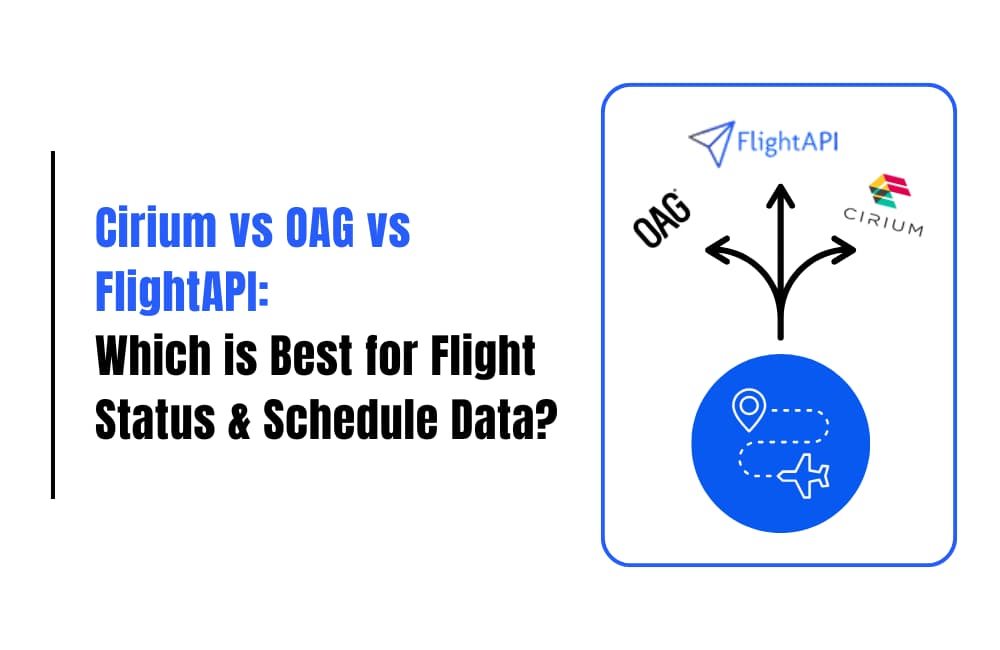
If you’re building apps for travel, managing airport ops, or keeping cargo moving, the right flight data is critical. From customer notifications to route planning and analytics, one inaccurate data feed can set off a chain reaction nobody wants to deal with. And you’re not the only one feeling the pressure. In 2024, the aviation analytics market is valued at USD 2.58 billion, projected to climb to USD 7.45 billion by 2032. Demand for up-to-the-second flight status, accurate schedules, and deep historical datasets has never been higher. Cirium, OAG, and FlightAPI are three of the biggest names you’ll come across when you start hunting for data that won’t let you down. Cirium is known for its reach and legacy, OAG brings unmatched historical depth, and FlightAPI focuses on accessibility and transparency for developers and small businesses. In this guide, you’ll learn about their features, data coverage, pricing, and the sort of use-cases each one truly excels at, so you can decide who earns a spot in your tech stack and who’s better left for someone else. What Data Do FlightAPI, Cirium, and OAG Provide? When choosing a flight status api. You’re handing over the keys to your app’s reliability, customer experience, and even compliance. Here’s a detailed Overview, Data Coverage, and Sources for each. FlightAPI FlightAPI is designed for today’s digital businesses, platforms, and startups that want simple, fast access to flight status, schedule, and pricing data without the complexity or cost of legacy providers. Their focus is on rapid integration, clear documentation, and cost transparency, which makes them appealing for developers, startups, and enterprises. Data Coverage Data Sources: Direct from Airlines and Airports: FlightAPI sources live data straight from airlines and airport authorities, providing the most current and reliable flight information. So that you never have to rely on outdated or cached feeds. Industry Partnerships: Additional accuracy comes from established partnerships with trusted aviation data providers, strengthening coverage and filling in any gaps. No Stale Data: All updates are delivered in real time, so you always get up-to-the-minute status direct from the authoritative sources. You can also use this API with no-code tools like Google Sheets and automation platformscheck out these tutorials to see how: ➤ Build an App to Track Flights Between Any Two Airports ➤ Create a Flight Tracking Tool with Loveable ➤ Extract Airport Schedule Data with Python ➤ Check Airport Schedule Using Google Sheet and API ➤ Track Flights Between Airports with Google Sheet Cirium Cirium is a popular option for aviation data. Trusted by airlines, airports, finance, tech giants, and government agencies alike. They just don’t provide a flight status API, but also deliver analytics, fleet tracking, emissions data, and more. Cirium’s approach is all about direct industry integration and building trust with layers of validation, redundancy, and partnerships. They’ve spent over a century refining how they gather, clean, and distribute flight data, which makes them a go-to for enterprises where accuracy and reliability are non-negotiable. Data Coverage Data Sources OAG OAG is another name synonymous with aviation intelligence, going back to 1929. While they started out publishing printed timetables, OAG is now a digital powerhouse, offering not just flight schedules and live status, but also huge archives of historic data. Their platform is used by airlines, airports, travel companies, financial analysts, and tech businesses needing reliable flight status and performance insights. Data Coverage Data Sources Wrapping Up: So now you’re aware of what each provider brings to the table: FlightAPI works brilliantly for developers and smaller businesses after quick setup and transparent pricing, Cirium is the best fit for airlines and big organisations needing top-tier analytics and reliability, and OAG is your pick if you value deep historical data and broad aviation intelligence. If you’re looking for straightforward data access of flight status, schedules, live airport info, and easy integration. Try FlightAPI for free today.
Build an App to Track Flights Between Any Two Airports

TL;DR Learn how to build a no-code flight tracking app using FlightAPI’s Flight Tracking API and Loveable, with: ⚡ Easy setup — connect your API key in minutes 📜 Pre-written prompts for generating app logic 🧪 Testing guidance to verify live flight data 🚀 Deployment steps to publish your flight tracker Get live flight updates between any two airports, without writing a single line of code. If you work with travel, manage bookings, or just like building useful side projects, there’s a good chance you’ve thought about tracking flights between two airports. Maybe you’re a developer who wants to create a tool, or you run a business that needs live flight updates. Either way, most solutions out there feel too complex or need a lot of code. But what if you could create your own flight tracking app, from scratch, with zero coding and no headaches? Seriously, you don’t have to be a programmer to do this. You just need a couple of accounts, a working internet connection, and a little patience. Let’s see how simple it can be. What You’ll Need Step 1: Get Your API Key Head to FlightAPI and sign up for an account. After you register, you’ll get a verification email—click the link, and you’ll see your unique API key sitting there like it’s been waiting for you your whole life. Copy it somewhere safe. You’ll need it soon. As a bonus, your new account starts with 30 free API calls to help you get going. Step 2: Understand the API Endpoint and Test It Before you start, check out what kind of flight information you can get and how to ask for it. Take a quick look at the documentation page. You’ll see details on what you need for your requests, plus examples of the response you’ll get back. Here’s the endpoint you’ll use: For more details, check out the documentation. Step 3: Build an App with loveable Here’s where things get interesting. Sign up at loveable.app. The dashboard will feel familiar if you’ve ever chatted with an AI, ChatGPT, Gemini, or any other, but way more eager to code for you. Just start describing what you want: type in the chat about the API, share your design ideas (colors, layout, whatever floats your boat), and paste your API key in. The app generates a draft for you, and you can tweak it right there. If you change your mind about the look or need to add a new button, just say so, and it’ll handle it. It’s like having a coding intern who actually listens. Want to save even more time? I’ve got a ready-to-go prompt for you. (I’ve dropped it below, so you can just copy, add your api key in place of “api_key” adjust your details if you want to, and paste in loveable chat. Easy.) Prompt: Step 4: Test It and Fix What’s Needed Your app is live now. Go to your dashboard, fill in some airport codes, and see what comes back. But hold on, AI tools sometimes like to improvise, so let’s make sure everything works. To double-check, sign up for Postman if you haven’t already. Send a test request using the same airport codes. If the results from your app and Postman match, you’re set. If not, grab the response code from Postman, and let your AI helper at loveable know there’s an issue. It’ll analyze and fix things up for you. Step 5: Ready to Share You built it, you tested it, you fixed the errors. Now, show off your flight tracker! Loveable lets you use a custom domain, so you can put your app on the web with your address. Share it with friends, no code development, and the travel tech community, or even pitch it to your next client. If you have created this for a serious business, there are plenty of ways to turn your idea into something valuable. Wrapping Up In this blog, you learned how to build an app to track flights between any two airports using FlightAPI and loveable. FlightAPI also has other APIs, like flight status and flight price api, if you want to add more features to your projects. If you are aiming to bring your travel app idea to life in a digitally real mobile application, consider partnering with a trusted mobile app development company that can help you design scalable, high-performance applications tailored to your audience. Looking for more step-by-step guides? Thinking about more travel project ideas? There’s a list of the best travel APIs on the blog. Go see what grabs your attention. Sign up for FlightAPI today and start building your next travel tool.
How to Create a Flight Tracking Tool with Loveable
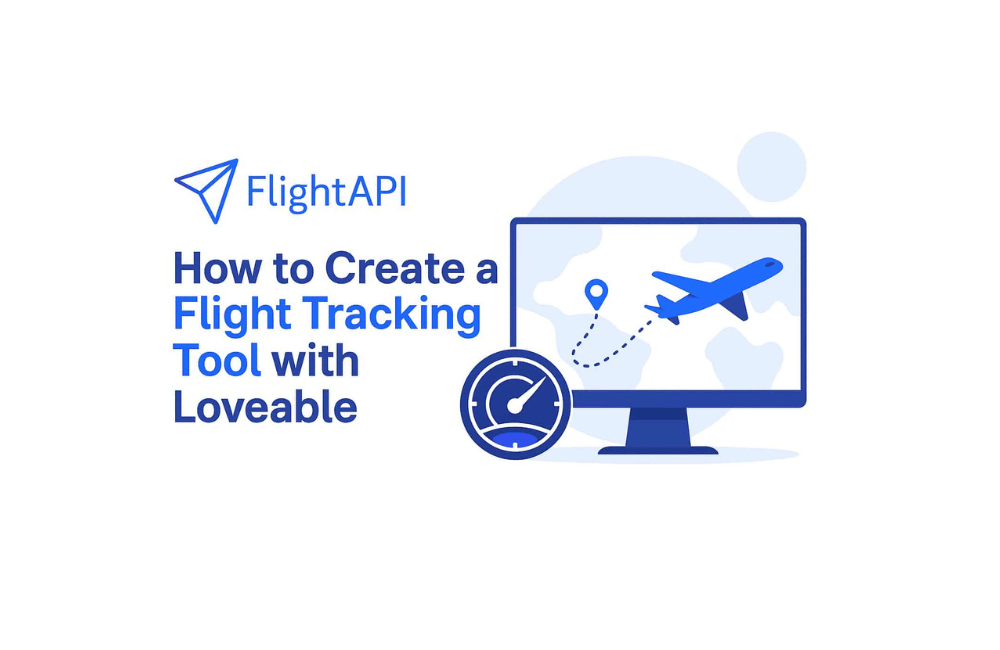
You need to track flight status. Maybe for your travel tech company, maybe for a client of your travel agency who needs updates by the minute, or maybe you’re a developer who’s just tired of overcomplicating simple things. What you’re not looking for is weeks of coding, a PhD in APIs, or apps that never quite do what you want. Here’s the easy path. In this guide, you’ll build a real-time flight tracker using a Flight Tracking API and Lovable. No mess. No headaches. Just a straightforward, step-by-step tutorial to create a flight tracking tool. Let’s get started. What You Need Step 1: Grab a Flight Tracking API Key Go to FlightAPI and create a free account. You’ll get 20 free credits as soon as you sign up. Don’t forget to verify your email. After you log in, you’ll see your API key on the dashboard. You’ll need to copy this key and add it into the Lovable app prompt (coming up in the next step). If you want to learn more about how the API endpoints and the response, check out the Flight Tracking API docs. Step 2: Make Your Lovable Account Go to lovable.dev and sign up. On the free plan, you get 5 free credits every day (up to 30 a month). Perfect for building and testing without opening your wallet. Step 3: Copy and Paste This Prompt into Lovable This is where things get fun. No need to overthink it. Copy this whole prompt and drop it into Lovable: Before you paste the prompt, make sure you swap out {API_KEY} with your own API key from the FlightAPI dashboard. Just copy your key, and replace the spot in the link that says {API_KEY}. This is how Lovable will connect to your FlightAPI account and get real flight info. Copy the prompt: Replace the API key in the URL with your own FlightAPI.io key Step 4: Test the Flight Tracker Now that Lovable has built your flight tracker, it’s time to see it in action. Just enter: Hit search, and you’ll see real flight info pop up right away—airport, terminal, gate, times, and more. Your tracker is ready to use. Watch it in action ⬇️ Want to change something? Maybe update the title or tweak the look? Just tell Lovable what you want to change right in the chat. It’ll handle it for you. Once you’re happy with how everything looks, hit publish. You’ll get a link to your tracker that you can share or use anywhere. Even better, you can put this tool on your own custom domain if you already have one. Final Words FlightAPI.io makes flight data easy for everyone, developers, non-coders, and travel businesses. It’s simple to use, and there are even more APIs to explore for things like prices, schedules, and more. Sign up for the free trial and see what you can build! Explore More Tutorials
How Business Intelligence for Travel Agency Is More Important Than Ever

The travel game is not what it used to be. Customers want more, competition’s brutal, and the pace is relentless. Whether it’s dynamic pricing, personalised offers, or real-time availability, decisions can’t be made on gut instinct anymore. You need sharp, actionable insights, not just numbers on a dashboard, but data that actually helps you move. Because if you’re not tracking, analysing, and acting on data in every part of your business, from bookings and customer behaviour to marketing spend, you’re flying blind. And in this post, we’re breaking down exactly why business intelligence has gone from “nice to have” to “non-negotiable” for travel agencies that want to stay in the game. And, if you aren’t leveraging it yet, what you’re missing and how can you flip that script. Let’s get into it. Understanding Business Intelligence in the Travel Industry Travel Business Intelligence (BI) is how travel agencies turn raw data into smart decisions. It’s not just about tracking what’s happened, it’s about knowing what to do next. BI tools help you spot trends, react faster, and plan smarter using real-time insights from every part of your operation. Here’s the kind of data you’re working with: Old-school analytics tells you the story after it’s happened. BI helps you write the next chapter. Why BI Is Now a Strategic Necessity — Not a Luxury The travel industry’s no longer playing catch-up. It’s full-on survival of the smartest. Demand is unpredictable, travellers want experiences built for them, and OTAs are securing market share faster than ever. If you’re still reacting to problems after they hit, you’re already behind. This is where Business Intelligence flips the game. Instead of guessing, you’re predicting. Instead of responding late, you’re adjusting early. For example, a travel agency uses BI to spot a drop in family holiday bookings two months out. With that heads-up, they launch a limited-time promo tailored for school holidays. Bookings bounce back, and they beat the crowd. That’s the edge. What used to be “nice to have” is now non-negotiable. This will help you stay relevant, profitable, and a step ahead. Major Benefits of Business Intelligence for Travel Agencies 1. Personalised Customer Experiences People don’t want cookie-cutter travel packages anymore. They want options that reflect their tastes, habits, and budget. That’s where BI becomes a game-changer for travel agencies. By digging into customer data, past trips, booking frequency, how much they typically spend, and where they like to go, agencies can shape offers that feel made for the individual. Whether it’s pushing family-friendly getaways to returning parents or city breaks to frequent solo travellers, you’re not guessing anymore. You’re acting on insight. This also makes loyalty programmes smarter. If you know what keeps people coming back, you can design better incentives, communicate more effectively, and stay top of mind when it’s time for their next trip. 2. Dynamic Pricing and Revenue Management Prices in the travel industry change fast. A surge in demand, a local event, or even weather patterns can shift what people are willing to pay. Business Intelligence helps agencies spot these trends early and adjust pricing accordingly. Instead of blanket discounts or fixed markups, you can work smarter and raise prices when interest spikes or run targeted promotions when traffic drops. That means better margins without scaring off price-conscious travellers. How a Flight Price API Can Help Travel Agencies If you want to make these kinds of pricing moves with confidence, FlightAPI is a reliable flight pricing api. It’s a powerful yet lightweight flight data API that gives you real-time access to flight prices, schedules, and status in an easy-to-use JSON format. With one GET request, you can pull accurate, live data from across all major vendors. That means you’ll know exactly when competitor pricing shifts, when certain routes get pricey, and how to react in the moment. For agencies that are looking to improve their pricing strategy, FlightAPI offers a simple, fast, and scalable solution. 3. Operational Efficiency & Cost Reductio Behind every inefficient process is a pile of data waiting to be looked at. BI helps you spot patterns that would otherwise go unnoticed. Whether it’s a recurring customer support issue, booking delays tied to certain suppliers, or gaps in staff coverage. With the right setup, you can see where time and money are being wasted and fix it before it becomes a bigger problem. For instance, if your enquiry response time drops during weekends, that’s a staffing issue you can fix. Improving remote communication between distributed teams can also significantly reduce delays in customer response times and coordination issues. If fraud keeps popping up from a specific payment method, BI flags it early so you’re not left cleaning up the mess later. 4. Smarter Marketing That Actually Converts Throwing money at ads is easy. Knowing what’s working? That’s where BI earns its keep. With access to real-time performance data, travel agencies can fine-tune campaigns as they run. A/B testing gets sharper, segment targeting gets tighter, and your ad spend actually works harder. You know which platform brings in leads, what content drives clicks, and what kind of offers convert. It also helps you stop wasting time on tactics that don’t move the needle. You can double down on what works. It could be an email, paid search, or influencer promos. 5. Better Control Over Vendors and Assets If you work with lots of suppliers, flights, hotels, car hire, and tour operators, you know how hard it can be to keep quality consistent. BI gives you visibility into who’s delivering and who’s dragging their feet. You can track service levels, spot underperformance early, and shift volume away from unreliable partners. Instead of relying on anecdotal feedback or quarterly reviews, you’ve got real data backing your decisions. That kind of transparency strengthens your vendor relationships, too. When expectations are backed by numbers, conversations become clearer, faster, and more productive. High-Impact Use Cases of Business Intelligence for Travel Agencies Understanding why business intelligence matters is step one. But what really
How to Check Flight Location with an API
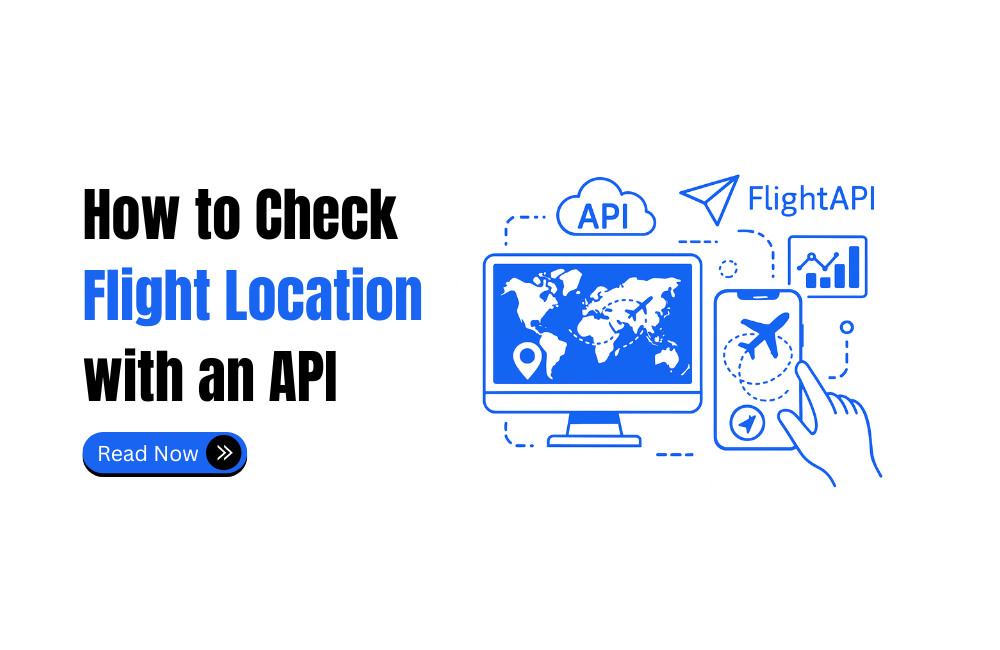
TL;DR This guide shows how to check real-time flight locations using FlightAPI’s Flight Tracking API. Readers learn how to get an API key, make a request with airline, flight number, and date, and interpret the response to see key details like status, airport, scheduled vs. estimated times, and exact terminal and gate locations. If you’re developing a travel application, managing logistics, or integrating flight data into your business systems, accessing accurate flight location information is crucial. In this guide, we’ll walk you through the process of retrieving flight location data using a Flight Tracking API. Let’s get started. Step 1: Obtain an API Key from FlightAPI.io Step 2: Make an API Request To test the API, you don’t need Postman. Just go to the dashboard, click on “Flight Tracking API” on the right side. A tool will open where you can enter the required details. The API URL will be generated automatically. Click “Try” to run it and see the API response below. If you want to test the API in your app or tech stack, use the following URL: Here’s what each parameter means: Update these values based on the flight you want to check. Step 3: Interpret the API Response The API will return a JSON response with key flight details, including the terminal and gate, which indicate the physical location of the flight at the airport. Key Fields: You can use the terminal and gate info to show where the flight is expected to board or land within the airport. Wrapping Up: Knowing where a flight will depart from or arrive at can be essential for many applications. Whether you’re building a travel tool or managing flight logistics, integrating this data can improve user experience and operational efficiency. So what are you waiting for? Sign up at FlightAPI.io and get 20 free credits to track flight locations. Additional Resources
Top 5 Airport Schedule APIs in 2025
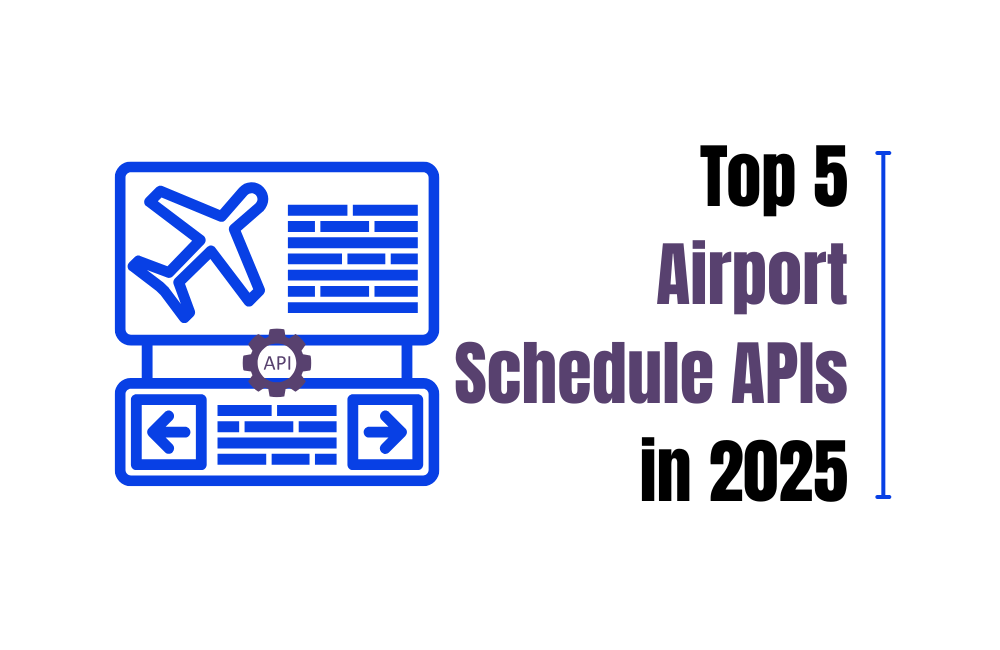
Looking for an airport schedule API that provides you the accurate data? That’s where things get tricky. A good airport schedule API gives you what you’d expect: flight numbers, airline names, arrival and departure times, and current status like “scheduled” or “delayed.” But some go further, including gate and terminal info, aircraft model codes, airport coordinates, timezone data, and even links to public sources like Wikipedia or airport images — all in one structured response. If you’re working with arrivals or departures and need more than just a timestamp and a flight number, these advanced APIs are worth a closer look. To make your search easier, we’ve listed the Top 5 Airport Schedule APIs in 2025, based on accuracy, data depth, and ease of use. Here’s what stands out. 1. FlightAPI The Airport Schedule API from FlightAPI offers structured access to flight schedules for any airport, with support for both arrivals and departures. It pulls flight data from the last two days to three days ahead, or up to a 10-day window if no specific date is passed. The data includes flight numbers, status, departure and arrival times, airline info, and even aircraft codes. Each response also provides detailed airport metadata like IATA and ICAO codes, location coordinates, timezone info, elevation, and optional links to Wikipedia and image sources. It’s useful if you’re adding contextual or location-based elements. To fetch data, you only need a few required parameters: your API key, the airport’s IATA code, and the mode (arrivals or departures). There’s also an optional day parameter to customize your date range. Documentation: Airport Schedule API Docs If you’re a no-code developer or prefer working with spreadsheets, you can also use the API directly inside Google Sheets. Check out this quick walkthrough 👉 Get Airport Schedule Using Google Sheets and API Other APIs FlightAPI offers: 2. Aviyair Aviyair’s Current Airport Schedules API provides real-time access to live airport timetable data. With just two required fields — the airport IATA code and schedule type (arrival or departure) — you can pull live schedule updates directly into your application or system. The API supports over 20 optional filters to narrow results, including airline, terminal, gate, status, flight number, delay duration, and more. It returns all key timetable data like scheduled, estimated and actual times, terminal/gate info, airport IATA/ICAO codes, airline identifiers, flight status, and codeshare details when available. Developers can also combine this with Aviyair’s future schedules API to enrich responses with common aircraft model data per flight number. The JSON REST structure is designed to work across modern languages, including JavaScript, Python, PHP, and others. Documentation: Aviyair Current Airport Schedules API 3. GoFlightLabs GoFlightLabs provides an airport schedule API that returns real-time departure and arrival data based on the airport’s IATA code. You can set the schedule type as either departure or arrival, and add filters like airline, flight number, or timestamps to narrow things down. Each response includes the essentials — flight number, airline codes, terminals, gates, scheduled times, and current status. You also get timestamps for estimated and actual events, delay durations, and aircraft ICAO codes. Baggage carousel info and codeshare identifiers show up when available. The API is delivered in JSON format and includes both local and UTC timestamps for time-based tracking. Documentation: GoFlightLabs Flights Schedules API 4. SITA SITA offers a Flight Schedule API built for global aviation data needs, providing access to scheduled flights between airports, including future flight details. The API is designed to work with both city and airport codes (IATA), making it flexible for a variety of schedule-based applications. The output typically includes flight numbers, airline details, departure and arrival airports, scheduled times, and frequency of service. It’s suitable for displaying available flight connections, planning logistics, or integrating schedule insights into aviation platforms. This API focuses on scheduled data rather than real-time updates. It is an ideal API when you’re building around published timetables rather than tracking live statuses. Documentation: SITA Flight Schedule API 5. AviationStack AviationStack provides a flight data API that includes both real-time and historical schedule information. With support for global airports and airlines, the API lets you pull live departure and arrival data using airport IATA codes, along with key details for each flight. Each response includes flight number, airline info, status (like active, delayed, cancelled), scheduled and estimated times, terminals and gates (when available), as well as airport codes for both origin and destination. Aircraft type data and timestamps in both local and UTC formats are also included. You can query by airport, airline, flight number, or date which makes it flexible enough for tracking schedules or building real-time flight boards. Documentation: AviationStack API Docs Conclusion: Airport schedule APIs vary in how much data they offer and how easy they are to work with. Whether you need real-time departures, future schedules, or historical records, the right tool depends on your use case. The five listed here cover a solid range of features, formats, and filtering options. Explore the docs, test a few endpoints, and choose the one that fits your workflow best.
How to Track Flights Between Airports With Google Sheet and FlightAPI
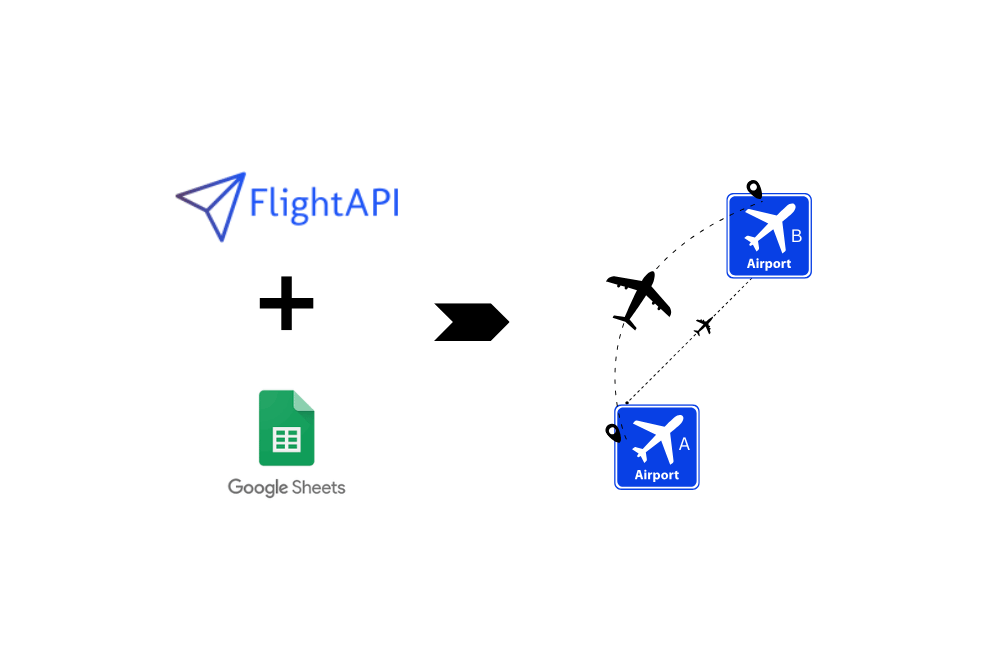
TL;DR Learn how to set up a Google Sheet that pulls live flight data between airports using FlightAPI’s Flight Tracking API. The guide shows how to get your API key, structure input/output sheets, add an Apps Script, and run it to automatically fetch flight details like airline, flight number, status, and times — plus it includes a ready-to-use Google Sheet template for instant setup. If you’re managing travel logistics, coordinating shipments, running a travel agency, or overseeing business operations where tracking flights between airports is needed. This tutorial is built for you. In this tutorial, we’ll show you exactly how to create a simple tool to track flights between airports using Google Sheets and a Flight Tracking API. No code, no tech headaches. Just a fully functional solution you can build from scratch and start using today. Moreover, at the end of the tutorial, you will also get a ready-made blueprint. You can download it, plug in your details, and start pulling live flight data in minutes. What You’ll Need: Step 1: Get Your API Key (In a free account, you will get 50 credits. Using the flight tracking between airport API costs 1 credit per response, which is pretty good for testing purposes. For more credits, you can upgrade your account as per your needs.) Step 2: Prepare Your Spreadsheet Before you set up your spreadsheet, you’ll want to review the API documentation here: Track Flights Between Airports API. This will show you which parameters you’ll need to send and what kind of data you’ll get back. Now, based on that information, let’s set up two tabs in Google Sheets: Input and Output. In the “Input” sheet: You’ll create a simple table where you’ll add the details of the flights you want to track. Here’s what you need: In the “Output” sheet: This is where the magic happens. This tab will show the flight data pulled directly from FlightAPI. Here are the columns to include: Step 3: Edit Apps Script and Run It With your spreadsheet ready, it’s time to make things work behind the scenes. This step will automate the process – pulling data from your Input sheet (your API parameters) and placing the results into the Output sheet. Here’s what to do: 6. In the script you just pasted, look for the placeholder text “your_api_key”. Delete “your_api_key” and replace it with your actual API key from the FlightAPI dashboard. This will authenticate your requests and allow the script to fetch live flight data. 7. After updating your API key, click Save (the floppy disk icon) in the Apps Script editor. 8. Next, hit Run from the toolbar. The first time you run the script, Google will pop up a permissions window asking you to authorize the script to access your Google Sheet. This is standard when using Apps Script to automate tasks. 9. Head back to your spreadsheet and check the Output tab — you’ll now see the live flight data neatly organized into columns. The tool will pull flight details like airline, flight number, status, times, and more, all arranged and ready for you to use. Get Your Ready-to-Use Blueprint If you’d rather skip building the tracker from scratch, we’ve got you covered. Click the link below to access the Google Sheet template. Simply make a copy, enter your flight details in the Input tab, insert your API key into the Apps Script (as outlined in this guide), and run it. You’ll be ready to start pulling flight data in no time. 👉 Download Your Flight Tracker Template Wrapping Up You’ve now got a working flight tracking tool inside Google Sheets — no coding headaches, no extra software, just simple automation using FlightAPI. Whether you’re managing travel operations, tracking cargo movements, or supporting customer travel needs, this setup saves time and delivers real-time flight data exactly where you need it. If you’re looking to extend your automation even further, check out these resources. You might need more than just flight tracking down the line — from real-time schedules to broader data sets, these guides have you covered: More Tutorials to Level Up Your Workflow:
How to Check Airport Schedule using Google Sheets and Airport Schedule API?

Finding flight schedules for an airport shouldn’t feel like searching for a needle in a haystack. But hopping between airline websites, refreshing pages, and manually compiling data? That’s a time-wasting nightmare. What if you could get all that information directly in a Google Sheet—automatically? No coding, no complex setups—just a simple process that fetches real-time airline schedules in seconds. In this guide, you’ll learn how to use Google Sheets and an API to extract airport schedules with ease. Follow the steps, set up your tool, and by the end, you’ll also get a blueprint sheet so you can plug in your details and get started instantly. Let’s get to it. What You’ll Need: Step 1: Get Your API Key Step 2: Create Google Sheet Step 3: Add the Apps Script to Google Sheets Now that you have the required details, it’s time to insert the script into your Google Sheet. Follow these steps: Step 3: Edit the Apps Script Code 1. Your API Key 2. Select the Date for Schedule Data The API allows you to fetch schedules for yesterday, today, or tomorrow, using numerical values: Add the numbers accordingly in the script here. 3. Choose Arrival or Departure Data The API allows you to pull data for either: “arrivals” → To get incoming flights “departures” → To get outgoing flights In the script, look for the mode and change it based on what you need. If you need additional options or details about the API, check out the Airport Schedule API documentation. Step 5: Save, Run the Script, and Check the Output Download the Pre-Built Blueprint No need to start from scratch—simply download the pre-built blueprint, make the necessary changes, and run the script to start fetching flight schedule data instantly. Click here to download your copy Wrap Up: With this Google Sheet blueprint, you can effortlessly track airport schedules. Flightapi.io not only offers Airport Schedule API but also offers Flight Price API and Flight Status API for catering to various data needs. If you’re looking to delve deeper into flight data extraction, whether through Python or no-code solutions, explore these additional resources to enhance your capabilities and streamline your data management processes.
How to Extract Airport Schedule Data with Python
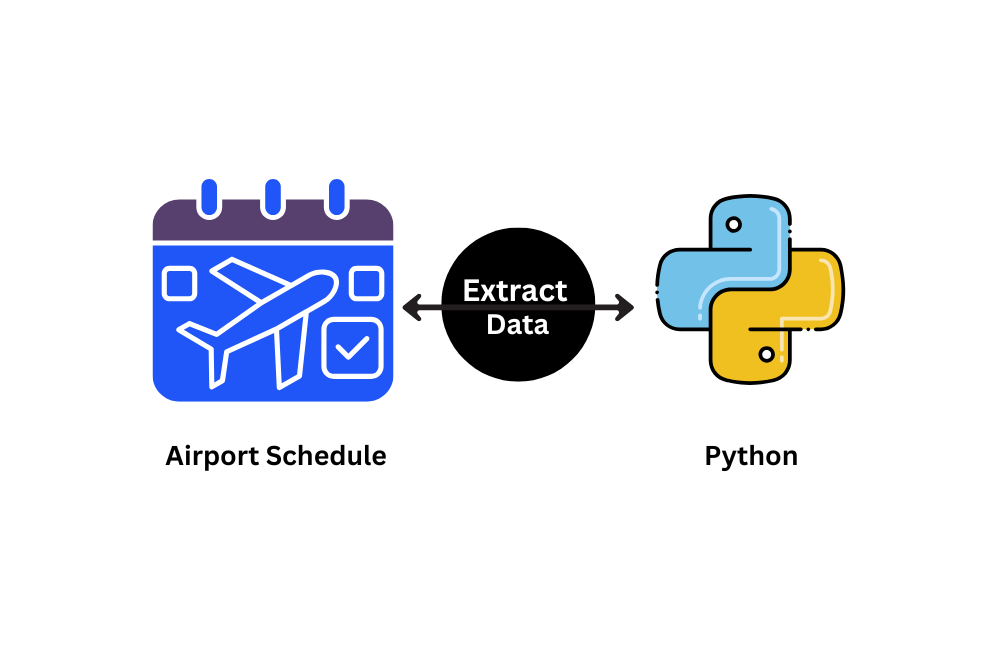
Airport schedule data is crucial for flight tracking, travel planning, airline operations, and aviation analytics. In this guide, we will demonstrate how to extract real-time airport schedule data using Python. By the end of this tutorial, you’ll be able to fetch flight arrival and departure schedules using a simple API request. What is Airport Schedule Data? Requirements I hope you have already installed Python on your machine, if not then you can download it from here. Then create a folder where we will keep all the files. mkdir flightdata Then inside this folder install requests and pandas library. pip install requests Now, create a Python file using any name you like. I am naming the file as schedule.py. The final step would be to create a trial account on FlightAPI. You will get 30 credits for testing the API. Extracting Airport Schedule Data Once you sign up for the trial pack you will be redirected to the dashboard which will look like this. Before proceeding with the coding, it would be great to read the documentation to get the full idea of how the airport schedule API works. import requestsAPI_KEY = “your-api-key”AIRPORT_CODE = “JFK”mode=”arrivals”URL = f”https://api.flightapi.io/schedule/62677fded20b140b78fa40bc?mode={mode}&iata={AIRPORT_CODE}&day=1″response = requests.get(URL)if response.status_code == 200: airport_data = response.json() print(airport_data) else: print(f”Error: {response.status_code}”) Let me briefly explain the code. Let’s run the code and see what appears. You got a beautiful JSON response for all the arriving flights at JFK. Let’s parse the schedule data out of this huge JSON data. For your simplification, the data looks like this. From this, we need schedule data. But if you need weather or aircraft image data then you can parse that too. import requestso={}l=[]API_KEY = “your-api-key”AIRPORT_CODE = “JFK” # Replace with your airport codemode=”arrivals”URL = f”https://api.flightapi.io/schedule/62677fded20b140b78fa40bc?mode={mode}&iata={AIRPORT_CODE}&day=1″response = requests.get(URL)if response.status_code == 200: airport_data = response.json() completeData=airport_data[‘airport’][‘pluginData’][‘schedule’][‘arrivals’][‘data’] for i in range(0,len(completeData)): try: o[“flight”]=completeData[i][‘flight’][‘aircraft’][‘model’][“text”] except: o[“flight”]=None try: o[“departure”]=completeData[i][‘flight’][‘time’][‘scheduled’][‘departure’] except: o[“departure”]=None try: o[“arrival”]=completeData[i][‘flight’][‘time’][‘scheduled’][‘arrival’] except: o[“arrival”]=None l.append(o) o={} print(l)else: print(response.text) print(f”Error: {response.status_code}”) After running the code you will get this parsed JSON response. Saving the data to a CSV file Our parsing is done now let’s save the data directly to a CSV file. We will use pandas for this process. import requestsimport pandas as pdo={}l=[]API_KEY = “your-api-key”AIRPORT_CODE = “JFK” # Replace with your airport codemode=”arrivals”URL = f”https://api.flightapi.io/schedule/62677fded20b140b78fa40bc?mode={mode}&iata={AIRPORT_CODE}&day=1″response = requests.get(URL)if response.status_code == 200: airport_data = response.json() completeData=airport_data[‘airport’][‘pluginData’][‘schedule’][‘arrivals’][‘data’] print(len(completeData)) for i in range(0,len(completeData)): try: o[“flight”]=completeData[i][‘flight’][‘aircraft’][‘model’][“text”] except: o[“flight”]=None try: o[“departure”]=completeData[i][‘flight’][‘time’][‘scheduled’][‘departure’] except: o[“departure”]=None try: o[“arrival”]=completeData[i][‘flight’][‘time’][‘scheduled’][‘arrival’] except: o[“arrival”]=None l.append(o) o={} df = pd.DataFrame(l) df.to_csv(‘schedule.csv’, index=False, encoding=’utf-8′) print(“done”)else: print(response.text) print(f”Error: {response.status_code}”) Once you run this code you will see a CSV file by the name schedule.csv inside your folder. Conclusion Extracting airport schedule data using Python and FlightAPI.io is a powerful way to access real-time flight arrivals, departures, and status updates. By leveraging APIs, we can efficiently fetch, process, and analyze flight data without relying on manual tracking or unreliable sources. Apart from airport schedule data, FlightAPI.io offers a range of other services, including flight price comparison data from different vendors through its Flight Price API. You can explore the documentation for different trip types: Additionally, it offers a Flight Status API that allows you to retrieve real-time flight tracking data using Python, including flight number, departure airport, scheduled departure time, arrival airport, and scheduled arrival time. If you prefer a no-code solution, check out our step-by-step tutorial on automating flight status data extraction using Google Sheets.
Airline Data Analytics: Benefits, Challenges, and Future Trends

Airlines are moving fast to keep up with tech and changing travel trends — and data is now playing a huge role in how they do it. Valued at USD 2.6 billion in 2023 and expected to grow at a robust 10.14% annually through 2030, the aviation analytics market is reshaping how airlines operate. (source) From optimizing flight routes and enhancing customer experiences to predicting maintenance needs and managing risks, data analytics provides airlines with critical insights to improve efficiency and drive growth. However, integrating these advanced technologies comes with its own set of challenges. In this blog, we will not only explore the immense benefits of data analytics in the airline industry but also the hurdles that must be overcome to fully harness its potential. Let’s start with the benefits. Key Business Advantages of Data Analytics in Airline Industry 1. Revenue Management Business analytics in the airline industry helps businesses to understand traveler demand and optimize pricing for maximum profitability. Traditional statistical approaches are no longer sufficient for analyzing the vast amounts of data that airlines must consider when pricing flights and understanding demand. Using data science, airlines can now leverage sophisticated methods to perform demand analysis. For example, behavioral data from travelers can be used to identify leisure demand, while data from professional networking sites and recruitment and procurement activities can signal emerging business travel destinations. Machine learning-based clustering can also group thousands of origins and destinations by similarities, taking into account various parameters like the time of travel, duration of stay, and more. Moreover, revenue teams can also rely on competitive flight pricing data to adjust fares at the best possible rate according to demand and competition to secure more bookings. For doing so, Flight Price API has become an important tool for airlines to track flight prices across different booking applications, websites, and OTAs. Watch the tutorial to learn how to retrieve real time flight price data by using FlightAPI. Despite that, if you’re looking for APIs for different airline or travel data needs, check out these travel API providers. 2. Route Data Using data analytics in airline businesses can plan flight routes more efficiently. This helps them to ensure timely arrivals for passengers and reduce fuel consumption, and overall cost. For doing this, airlines need access to real-time flight data and route information, and by using a reliable Flight Tracking API they can make informed decisions for their airline route planning. Want to pull flight schedule data into a Google Spreadsheet in a simple, easy-to-read format? Just enter the airline code and flight number, and you’re set. Check out our guide on ➡️ automating flight status data extraction using a flight tracking API and Google Sheets. By the end, you’ll have a complete blueprint ready to download—plug it in, and you’re good to go! 3. In flight Sales and Food Supply Estimation The utilization of big data software for analytics in the airline industry has become indispensable, particularly in the areas of in-flight sales and food supply estimation. By diving into data, airlines can make informed decisions about food offerings and accurately forecast customer demand, which ultimately helps optimize inventory and minimize waste. For instance, airline analytics open doors for examining historical sales data to identify which food and beverage items are more likely to sell on specific routes at different times of the day. This knowledge can guide their inventory planning to ensure that the most popular items are always readily available. Similarly, analyzing data from similar routes can help airlines anticipate the food needs for new routes, minimizing any possible food shortages or wastage. Furthermore, real-time data from in-flight entertainment systems can help airlines stay on top of passenger’s preferences and tailor their snack and beverage offerings and entertainment choices accordingly. 4. Helps in Predictive Maintenance Data analytics helps aviation industries save costs and increase revenue streams by using Big Data, IoT, and predictive analytics. Airlines analyze data to anticipate aircraft part refurbishment or repair needs before they break down, reducing unplanned maintenance costs and associated delays. Plus, predictive data analytics monitors engine temperature, fuel consumption, and flight patterns to identify trends and provide insights into maintenance needs By using data analytics for predictive maintenance, aviation companies benefit from improved safety, efficiency, and profitability by streamlining maintenance schedules and increasing aircraft uptime, leading to higher customer satisfaction scores and increased revenue streams. 5. Helps in Risk Management The demand for flight data analysis is increasing at a fast pace in the aviation industry since industry experts have become aware of the usefulness of managing risks and preventing accidents. To make this possible, airlines use data analytics in aircraft maintenance, and crew management programs to predict and manage pilot fatigue, reducing risks and ensuring safe operations. By analyzing factors such as pilot schedules and flight times, airlines can identify potential risks and take proactive measures to prevent accidents, improve safety, and reduce costs. 6. Efficient Forecasting Effective flight prediction plays a pivotal role in enabling airlines to make informed decisions on a range of critical factors, including but not limited to seat capacity expansion, rate adjustments, and the introduction of new routes. To achieve precision in forecasting, airlines must leverage the power of data analytics as it remains an indispensable tool in the modern aviation industry. You just learned about how data analytics is revolutionizing the airline industry and propelling businesses to new heights. But wait for a moment, there are some serious challenges you need to be aware of if you want to stay ahead of the game. Check them out NOW! Challenges of Data Analytics in the Airline Industry Here are a few challenges of data analytics that the airline industry needs to overcome. Data Integration: Integrating different data sources into a single database is not always an easy task. Data Quality: Incomplete, inaccurate, or inconsistent data can lead to incorrect conclusions and decisions. Data Security: Like any other industry, data security is a top priority. Protecting data from cyber threats

